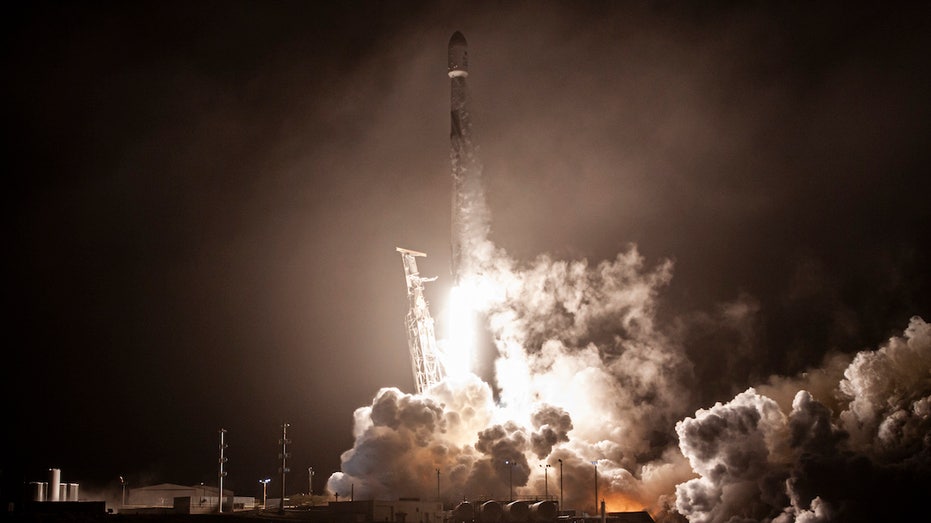'Armageddon' star Bruce Willis trends on social media after NASA's DART launch
DART, the world's first full-scale planetary defense system, will intercept the Didymos asteroid system between Sept. 26 and Oct. 1, 2022
SpaceX crashes NASA spacecraft into asteroid approaching Earth
SpaceX crashes NASA spacecraft into asteroid approaching Earth
Actor Bruce Willis briefly trended on Twitter Wednesday following the successful launch of NASA's Double Asteroid Redirection Test (DART) mission, the world's first full-scale planetary defense system.

Photos courtesy of NASA, Mike Marsland/WireImage via Getty Images (Getty Images)
According to a tweet by Washington Post reporter Christian Davenport on Tuesday, NASA administrator Bill Nelson said he invited Willis to watch the launch because of his role in the film "Armageddon." Though Willis declined the invite, Nelson said the agency "did not want to miss that connection."
A spokesperson for Willis did not immediately return FOX Business' request for comment.
BLUE ORIGIN TAPS MICHAEL STRAHAN, OTHERS FOR NEXT FLIGHT
Political scientist and author Ian Bremmer jokingly wished Willis luck on his "important mission". Meanwhile, one Twitter user quipped that Willis couldn't make the launch because he is "Moonlighting", a reference to one of his other films, while another asked if he'd make it back in time for Christmas.
In addition, a Twitter user noted how it is amazing to see "humans making sci-fi a reality."
ELON MUSK SAYS SPACEX ‘HOPING’ TO LAUNCH STARSHIP'S FIRST ORBITAL FLIGHT IN JANUARY
The DART spacecraft lifted off on a SpaceX Falcon 9 rocket from Space Launch Complex 4 East at Vandenberg Space Force Base in California at 1:21 a.m Eastern time Wednesday. The mission is costing NASA approximately $330 million.

A SpaceX Falcon 9 rocket lifts off from Space Launch Complex 4 at Vandenberg Space Force Base in California on Nov. 23, 2021, carrying NASA’s Double Asteroid Redirection Mission spacecraft.
DART, which is managed by the Johns Hopkins Applied Physics Laboratory, is on its way to intercept Dimorphos, a moonlet located in the Didymos asteroid system that spans 530 feet in diameter. Dimorphos completes one orbit of Didymos every 11 hours and 55 minutes. The Didymos asteroid is approximately 2,560 feet in diameter.
GET FOX BUSINESS ON THE GO BY CLICKING HERE
DART, whose goal is to slow Dimorphos down and cause it to fall closer toward Didymos, will use a deflection method known as kinetic impact, where it will intentionally collide with the asteroid at roughly 4 miles per second and shave approximately 10 minutes off its orbit. The change in the orbital period will be measured by telescopes on Earth. The minimum change for the mission to be considered a success is 73 seconds.
"DART is turning science fiction into science fact and is a testament to NASA’s proactivity and innovation for the benefit of all," Nelson said in a statement. "In addition to all the ways NASA studies our universe and our home planet, we’re also working to protect that home, and this test will help prove out one viable way to protect our planet from a hazardous asteroid should one ever be discovered that is headed toward Earth."
Prior to DART's impact, a cube satellite from the Italian Space Agency will be released to capture images of the collision and any material that is ejected. Roughly four years after DART’s impact, the European Space Agency's Hera project will conduct detailed surveys of both asteroids, with particular focus on the crater left by DART’s collision.
DART, which is expected to intercept the asteroid system between Sept. 26 and Oct. 1, 2022, will continue to travel just outside of Earth’s orbit around the Sun for the next 10 months until Didymos and Dimorphos are about 6.8 million miles away from Earth.
The Associated Press contributed to this report





















